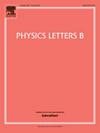探索38,39ti可能的双质子放射性
IF 4.3
2区 物理与天体物理
Q1 ASTRONOMY & ASTROPHYSICS
引用次数: 0
摘要
双质子(2p)放射性代表了一种罕见的衰变模式,仅在实验中观察到少数几个原子核。探索2p发射对于阐明外来富质子核内的结构、质量和核子-核子相互作用至关重要。39Ti一直被认为是2p发射的潜在候选者;然而,实验研究尚未证实它的2p衰变。为了给进一步的研究提供更准确的信息,我们利用伽莫夫壳模型(GSM)和伽莫夫耦合通道(GCC)方法分析了同位素38,39ti的预期2p放射性。我们的计算表明39Ti确实是2p发射的可行候选者。值得注意的是,根据三体GCC方法预测的39Ti的部分2p衰变宽度表明,它的2p衰变在可能性上可以与β衰变相媲美,尽管这高度依赖于特定的2p衰变能量。此外,我们的分析表明39Ti的价电子质子之间有配对的倾向。类似的研究方法表明,38Ti比39Ti具有更高的2p衰变能量和更宽的衰变宽度,使其成为更有希望的2p衰变候选者。本文章由计算机程序翻译,如有差异,请以英文原文为准。
Exploring the possible two-proton radioactivity of 38,39Ti
Two-proton (2p) radioactivity represents a rare decay mode that has been experimentally observed only in a selected few nuclei. The exploration of 2p emission is crucial for elucidating the structure, mass, and nucleon-nucleon interactions within exotic proton-rich nuclei. 39Ti has long been postulated as a potential candidate for 2p emission; however, experimental investigations have yet to confirm its 2p decay. To provide more accurate information for further studies, we utilize the Gamow shell model (GSM) and the Gamow coupled channel (GCC) method to analyze the prospective 2p radioactivity of isotopes 38,39Ti. Our calculations suggest that 39Ti is indeed a viable candidate for 2p emission. Notably, the estimated partial 2p decay width for 39Ti, predicted from the three-body GCC method, suggests that its 2p decay could rival its β decay in likelihood, although this is highly dependent on the specific 2p decay energy. Additionally, our analysis indicates a propensity for pairing between the valence protons in 39Ti. A similar investigative approach reveals that 38Ti exhibits a higher 2p decay energy and a broader decay width than 39Ti, positioning it as a more promising candidate for 2p decay.
求助全文
通过发布文献求助,成功后即可免费获取论文全文。
去求助
来源期刊

Physics Letters B
物理-物理:综合
CiteScore
9.10
自引率
6.80%
发文量
647
审稿时长
3 months
期刊介绍:
Physics Letters B ensures the rapid publication of important new results in particle physics, nuclear physics and cosmology. Specialized editors are responsible for contributions in experimental nuclear physics, theoretical nuclear physics, experimental high-energy physics, theoretical high-energy physics, and astrophysics.
 求助内容:
求助内容: 应助结果提醒方式:
应助结果提醒方式:


